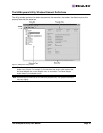
The HBAnyware Utility User Manual Page 1
Introduction
Emulex
®
drivers have many properties that you can modify using the HBAnyware
®
configuration utility.
The utility is client/server based and provides 'remote' configuration capability to other host platforms
running the utility. This remote configuration capability can be provided by either Fibre Channel (FC)
access (host systems on the same FC Storage Area Network (SAN) or by Transmission Control
Protocol/Internet Protocol (TCP/IP) access (from IP addresses of remote machines). The HBAnyware
utility also enables local discovery of Emulex and OEM branded Emulex host bus adapters (HBAs).
This manual supports the following versions of the HBAnyware application. Instructions are identical for
all operating systems except as noted.
• Windows
• Solaris LPFC
• Solaris SFS
• Linux
• Use the HBAnyware utility to do any of the following:
• Discover local and remote hosts, HBAs, targets and Logical Unit Numbers (LUNs)
• Enable local and FC discovery of Emulex and OEM branded Emulex HBAs
• Reset HBAs
• Set up persistent binding (Windows, Solaris LPFC and Solaris SFS)
• Set HBA driver parameters simultaneously to multiple HBAs using Batch Update
• Set global driver parameters to HBAs
• Update firmware and FC boot code (x86 BootBIOS, OpenBoot or EFIBoot) on a single
HBA or multiple HBAs using Batch Update
• Enable or disable the x86 BootBIOS
• Run diagnostic tests on HBAs
• Manage local, FC remote and TCP/IP accessed HBAs
• Locate HBAs using beaconing
• Mask and unmask LUNS (Windows, Solaris LPFC and Solaris SFS)
• Perform authentication using the Fibre Channel Security Protocol Diffie-Hellman Chal-
lenge Handshake Authentication Protocol (FC-SP DHCHAP) (Windows, Solaris LPFC
and Solaris SFS)
Known Issues
The following issues have been reported at the time of publication. These issues may not have been
verified or confirmed and may apply to another product, such as hardware.
• Emulex provides support for LightPulse
®
adapters that are reprogrammed with World Wide Port
Names (WWPNs) outside the typical Emulex range, such as Hewlett-Packard’s upcoming Virtual
Connect for Fibre Channel on the BladeSystem c-Class platform. In these environments, the
HBAnyware utility must be deployed across all servers on the SAN, and on any other
management console used for TCP/IP access management.
Note: The Linux 2.6 SCSI midlayer provides a number of additional services compared to
earlier Linux 2.4 kernels. For an overview of 2.6 SCSI and Emulex driver changes,
see the white paper on the Linux section of the Emulex Web site.


















